Sephora’s marketing strategy is a masterclass in how to build a brand presence that’s both trendsetting and trusted.
It’s no coincidence that when you think of beauty retail royalty, Sephora is one of the first names that comes to mind. With over 2,700 stores in 35 countries worldwide and a social following in the tens of millions, Sephora shows no signs of slowing down. In fact, last year, the brand saw record earnings, achieving double-digit growth in both revenue and profit.
But what exactly sets Sephora apart from other beauty retailers? And how have they built such a loyal, engaged audience both online and off? Let’s take a closer look at Sephora’s social media marketing strategy and uncover what brands can learn from its success.
A Snapshot of Sephora’s Social Media Presence
The beauty giant has a massive 48.2 million followers across Facebook, Instagram, TikTok, Twitter (or X), and YouTube. For comparison, its closest competitor, Ulta Beauty, has about 13.1 million across the same platforms.
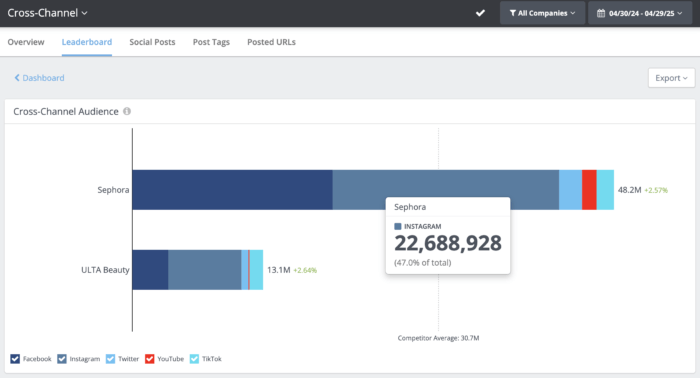
The biggest chunk of Sephora’s audience lives on Instagram, which makes up 47% of its total following (about 22.7 million), followed by Facebook at 42% (around 20 million). Not surprisingly, Instagram is also where Sephora is most active — 51% of its posts in the past year were on there. With such a large audience, it’s evidently a favored channel.
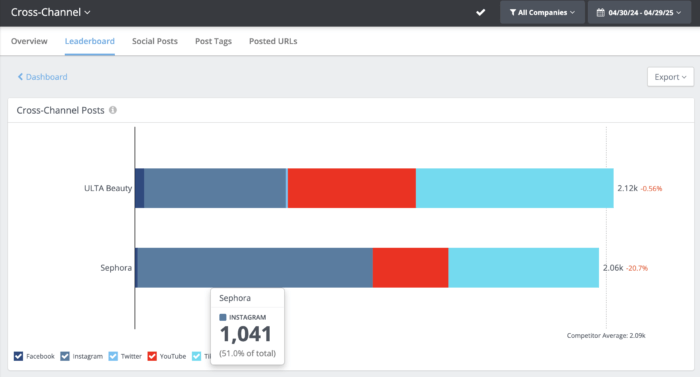
On TikTok, Sephora seems to be going all-in. Despite having a smaller following on there, the brand posted 667 times on TikTok in the past year, or about 32% of its total posts across channels. It’s a clear signal that Sephora is betting big on the platform’s potential for growth and influence.
Meanwhile, Sephora has pulled back from Twitter, posting nothing at all in the past year. This actually aligns with what we’ve seen across the health and beauty industry. As reported in our 2025 Social Media Industry Benchmark Report, brands are favoring platforms like TikTok and Instagram, which deliver higher engagement, while Twitter just isn’t pulling its weight.
Facebook activity has also been minimal (just 12 posts in the last year), showing that Sephora’s marketing strategy is focused on platforms that are currently delivering the most return.
And it’s working. Sephora averages around 12.5k engagements per post — almost 10x Ulta’s 1.29k per post.

While both brands have loyal fan bases, Sephora’s ability to consistently drive conversation, shares, and likes puts it in a league of its own when it comes to beauty retailers on social. Let’s take a look at what it’s doing to garner so much love.
Find out what is a good engagement rate on social media. 
Thinking Outside the Box With Unexpected Collabs
Sephora isn’t afraid to get creative and pair up with partners you wouldn’t immediately peg as beauty collaborators. In fact, it’s these unexpected team-ups that became some of the brand’s most buzzworthy posts of the past year.
Take its Faces of Music documentary, which premiered on Hulu. Featuring Becky G, Victoria Monét, and Chappell Roan, Sephora explored the connection between music, beauty, and makeup. The documentary was received well on social media, with a promo post seeing a 1.02% engagement rate by follower — 7x higher than the median engagement rate for health and beauty brands on Instagram (0.144%).
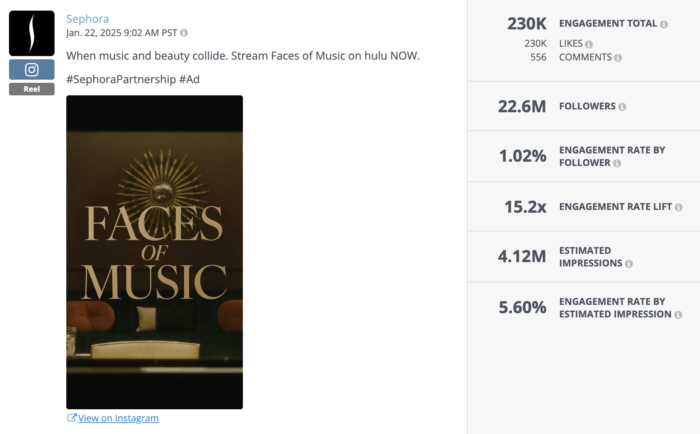
There was also the creative collab with @pollyther, who designed a miniature “Polly Pocket”-style Sephora store. Not only was it wildly creative, it also tapped into the ever-popular nostalgia trend, racking up major engagement. Sephora’s post achieved a whopping 9.43% engagement rate by follower. That’s 11x higher than the industry median and 5.5x higher than the median engagement rate for all industries on TikTok.
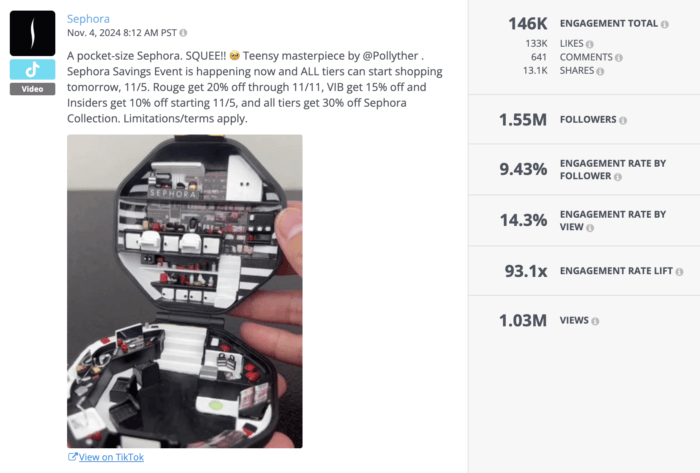
And in its most popular post, Sephora featured Tanner (@tannerwiththe_tism) from Netflix’s Love on the Spectrum for World Autism Awareness Day on both TikTok and Instagram. This collaboration drove hundreds of thousands of engagements and became Sephora’s most engaging TikTok from the past year.
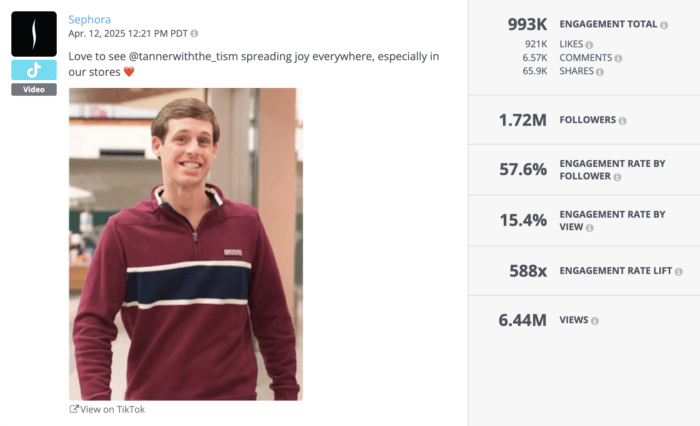
So why does this approach work? These out-of-the-box collabs are entertaining and strategic. They help Sephora reach new audiences, stand out among a sea of typical beauty content, and show that the brand gets what its community values.
Making It Interactive
Sephora doesn’t just talk at its audience — it invites them to join in. One clever play in its recent strategy was creating a custom TikTok effect that let users generate their own “makeup name.” The concept was simple. Each letter on the virtual keyboard corresponded to a beauty product, and users typed in their name to reveal their personalized product combo.
The original TikTok showcasing the effect racked up 208K engagements, earning a 15.4% engagement rate by follower. That’s 18x higher than the health and beauty industry median! Even more impressive? The effect was used in over 53,000 posts, giving Sephora greater exposure that reached well beyond their own followers.
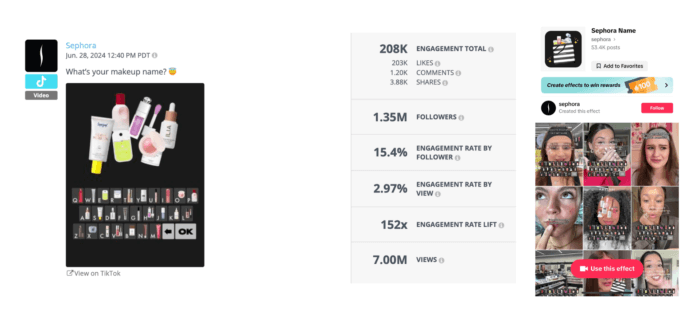
People love quizzes, filters, and games, especially when they’re at the center of it. This type of content taps into that universal appeal of interactivity while still spotlighting Sephora’s brand. Plus, when users post their own results, it creates a ripple effect. Friends see it, want to try it, and before you know it, the brand’s campaign becomes a trend.
Want to replicate Sephora’s success? Think about what kind of interactive experience aligns with your brand. Is it a filter? A quiz? A choose-your-own-adventure video? The key is to make it easy to use and fun to share. Bonus points if it helps people express themselves while subtly showcasing your brand and products.
Putting a Face to the Brand — Literally
Another effective strategy? Putting the spotlight on the founders of the brands it carries. It’s a smart move, especially for a retailer. Sephora stocks a lot of brands, which means the usual product promos can start to blur together. But when the founder of a brand shows up to hype up a new product launch or demo how to use it? That hits differently.
Take, for example, a trendy TikTok featuring Patrick Ta hyping up a new product drop. It became Sephora’s fourth most engaging post of the past year. With an engagement rate by follower of 15.7%, it far surpassed the health and beauty industry’s median engagement rate of 0.85%.
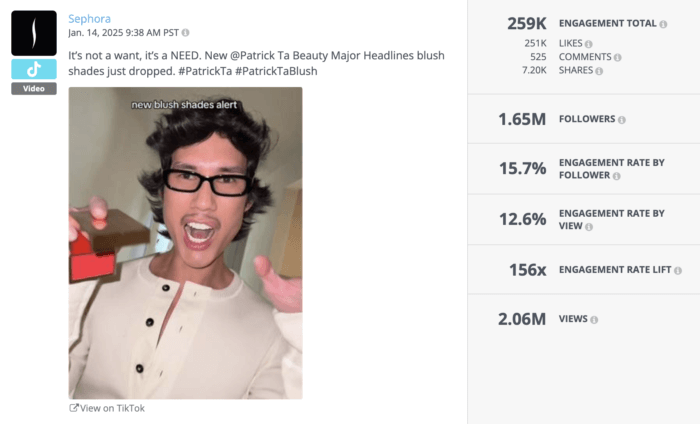
Over on YouTube, a tutorial with Haus Labs founder Lady Gaga sharing her updated makeup routine also stood out, becoming one of Sephora’s top-performing videos on the channel. Compared to other videos posted during the period we analyzed, it saw a 19x lift in engagement rate, showing just how powerful founder-led content can be.
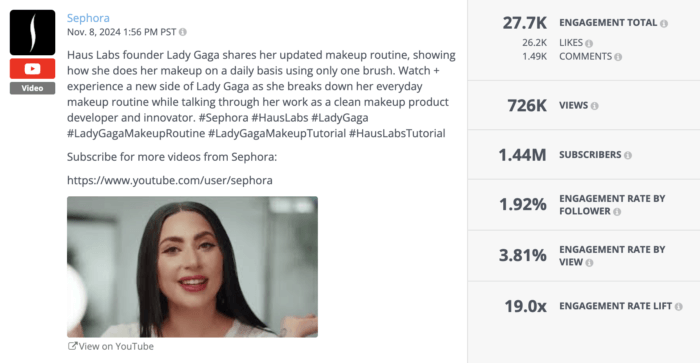
As a retailer with hundreds of brands, Sephora knows that a post from their account isn’t always going to land the same way as hearing straight from the source. When founders show up on Sephora’s channels — talking through their inspiration, applying products, or just having fun — it adds an element of authenticity and authority that a typical post can’t quite match.
Plus, fans of these founders (especially celebrities and industry names) are more likely to engage and share, pulling in new audiences and strengthening brand-fan relationships across the board.
Tapping Into Relatable Experiences
Not every post needs to be a major production featuring an A-list founder. Sometimes, a meme says it best. Sephora knows this and leans into relatability in a way that feels fun, self-aware, and in tune with its audience.
Take this Instagram post showing a before-and-after of a Sephora trip, with the “after” being a hand completely covered in makeup swatches. With a 1.61% engagement rate on Instagram, the photo outperformed the industry median of 0.14% by nearly 12x.
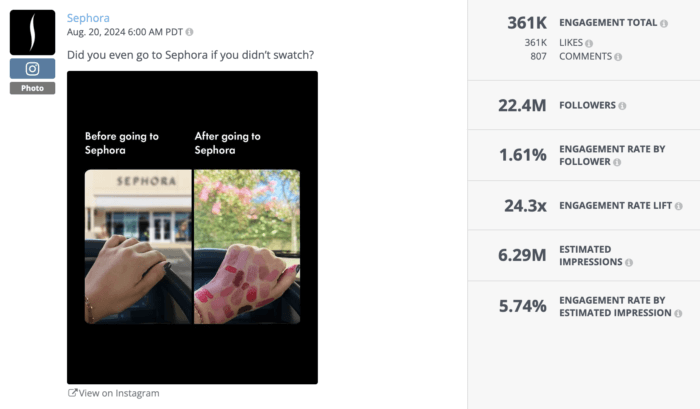
Or consider this post that earned 180K engagements, featuring an arm weighed down by Sephora shopping bags paired with the caption, “Beauty is pain.” These meme-like posts might be simple, but they’re high impact, racking up engagement by tapping into feelings beauty shoppers know well.
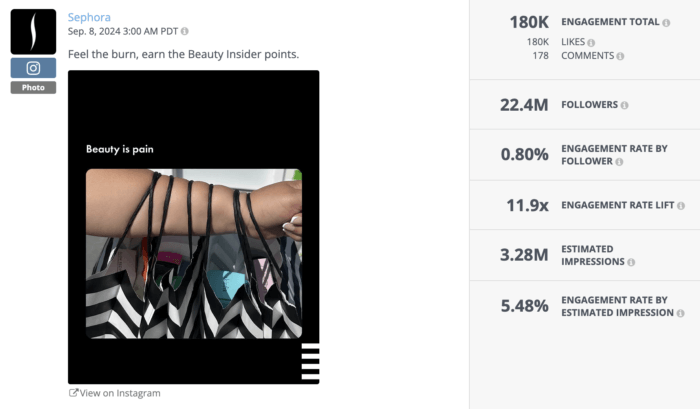
What’s just as strategic is where Sephora shares these posts. These posts rarely show up on TikTok or YouTube. Instead, they’re reserved for Instagram and occasionally Facebook — platforms where this format performs best.
That said, even a brand as savvy as Sephora doesn’t always get it right. And sometimes, testing content is exactly what you need to do to reveal what doesn’t land.
Learning What Doesn’t Work
While Sephora’s meme-style posts thrive on Instagram, the same approach doesn’t always translate to TikTok.
Case in point: this meme-style TikTok posted during Thanksgiving week, featuring a dancing turkey and a Sephora laptop backdrop celebrating an email outage. The post aimed for humor but fell short, earning only a 0.023% engagement rate by follower. That’s significantly lower than the health and beauty industry’s median of 0.85%. In fact, it ranked among the brand’s bottom 200 posts in terms of performance.
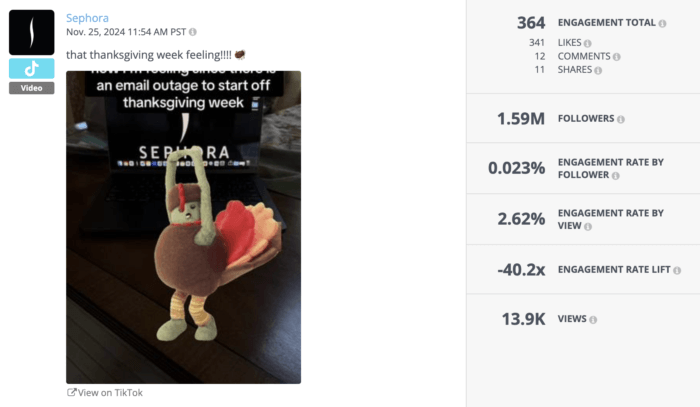
So what happened? It’s likely that the format just didn’t align with what Sephora’s TikTok audience expected. The humor was probably too niche or disconnected from the brand’s core identity on that platform. And it wasn’t a one-off. Several other underperforming TikToks followed a similar pattern.
To Sephora’s credit, though, the brand doesn’t overcorrect or double down on what doesn’t work. These kinds of posts are few and far between on TikTok, and instead of forcing a format, Sephora continues to focus its energy on what aligns with each platform’s strengths.
The lesson? Testing content across channels is smart but so is knowing when to pivot.
Methodology
To analyze Sephora’s marketing strategy, we used Rival IQ to take a closer look at the brand’s performance across social media platforms, including Instagram, Facebook, Twitter, TikTok, and YouTube. We looked at key metrics like engagement rates, follower counts, and post types.
The data in this breakdown covers the period from April 30, 2024, to April 29, 2025. We also pulled in insights from our 2025 Social Media Industry Benchmark Report to help us compare Sephora’s performance with other brands in the health and beauty space.
Start analyzing your social media with a free Rival IQ trial. 
Wrapping It Up
Sephora’s marketing strategy blends bold creativity with smart platform choices and genuine connection, making it a blueprint for how to build a social media presence that actually resonates with its audience. For any brand looking to do more than just show up online, there’s plenty of inspo to take from Sephora’s playbook.
